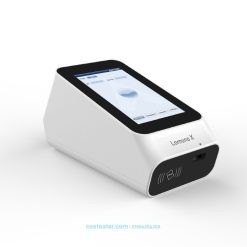Advanced Digital Radiography Solutions for Accurate Medical Imaging
৳ 1,350,000 1 Year Warranty
- Brand: DRTECH
- Model: EVS4343
- Origin: South Korea
- Certification: FDA
Experience the next level of medical imaging with our EVS4343 General Radiography System. Tailored for accuracy and efficiency, this advanced radiography solution ensures high-quality diagnostic images for comprehensive patient evaluations.
|
Purpose |
General Radiography |
|
Detector Type |
Csl by direct deposition |
|
Dimensions |
460(H) x 460(V) x 15.0(D) |
|
Weight |
4.5 kg |
|
Active Area |
430 x 430 mm |
|
Pixel Pitch |
140 um |
|
Resolution |
3,072 x 3,072 |
|
A/D Conversion |
14 bits |
|
Voltage |
DC 12V, 5A |
|
Power Consumption |
12W maximum |
|
Communication Interface |
1 Giga bps / IEEE 802.11n (2.4 / 5 GHz) |
|
X-ray Interface |
Lossless AED / Wired Interface Cable |
1 year warranty.
PC, Epson L1300 Inkjet Printer and UPS will be included to the package.
General radiography, often referred to as plain radiography or X-ray imaging, is a medical imaging technique that uses X-rays to produce detailed images of the inside of the body. It is commonly used to visualize bones, organs, and tissues to diagnose and monitor various medical conditions. General radiography is a fundamental tool in medical imaging and is widely employed in various healthcare settings.
Key Features of General Radiography:
- X-ray Generation: X-rays are electromagnetic waves that can penetrate the body. In general radiography, X-rays are produced by an X-ray tube.
- Patient Exposure: The patient is positioned between the X-ray source and a detector, which captures the X-rays that pass through the body. The amount of X-rays absorbed or scattered by different tissues produces an image.
- Image Formation: The X-rays that pass through the body create a shadow-like image on the detector, forming a radiographic image. Dense structures, such as bones, appear white (radiopaque), while less dense structures, like soft tissues, appear darker (radiolucent).
- Digital Radiography: Traditional film-based radiography has been largely replaced by digital radiography. Digital systems provide immediate image acquisition, easy storage, and the ability to manipulate and enhance images for better diagnostic accuracy.
- Applications: General radiography is used for a wide range of diagnostic purposes, including detecting fractures, assessing joint conditions, evaluating the chest for lung and heart conditions, and more.
- Safety Measures: To minimize radiation exposure, lead aprons and other protective measures are often used. The amount of radiation used in general radiography is carefully controlled to balance diagnostic needs with patient safety.
Clinical Uses of General Radiography:
- Orthopedic Imaging: Detecting fractures, dislocations, and bone abnormalities.
- Chest X-rays: Assessing lung and heart conditions.
- Abdominal Imaging: Examining organs in the abdomen, such as the liver and kidneys.
- Dental X-rays: Visualizing teeth and jaw structures.
- Mammography: Screening for breast cancer.














